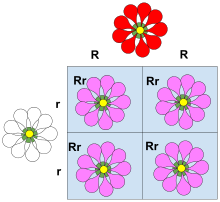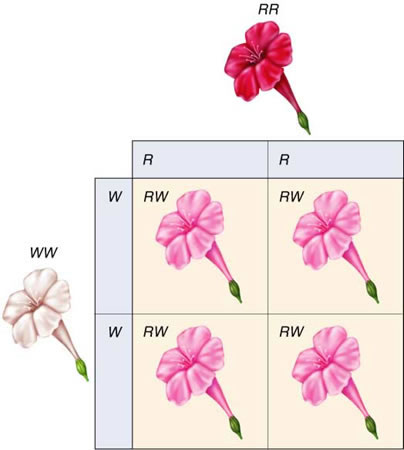Incomplete dominance which is also referred to as partial dominance, semi-dominance or intermediate inheritance occurs when the phenotype of the heterozygous genotype is distinct from and often intermediate to the phenotypes of the homozygous genotypes. For instance, it can be deduced that snapdragon flower color is homozygous for either red or white. When the white homozygous flower with red homozygous flower is paired the result yields a pink snapdragon flower. The pink snapdragon is seen as the result of incomplete dominance. A similar issue of incomplete dominance can be seen in the four o’clock plant wherein pink color is produced when true-bred parents of white and red flowers are crossed. In quantitative genetics , in which phenotypes are measured and treated numerically, when a heterozygote’s phenotype is exactly between (numerically) that of the two homozygotes, the phenotype is said to exhibit no dominance at all, i.e. dominance do exist only when the heterozygote’s phenotype measure lies closer to one homozygote than the other.

The Punnett square image illustrates incomplete dominance. The red petal trait associated with the R allele recombines with the white petal trait of the r allele. The plant incompletely shows the dominant trait (R) causing plants with the Rr genotype to exhibit flowers with less red pigment resulting in pink flowers. The colors seem not blended together, the dominant trait is just expressed less strongly.
Therefore, Incomplete Dominance does occur when one allele for a specific trait can not completely be expressed over the other. This gives birth to a third phenotype, through which the expressed physical trait is a combination of both alleles. Which is not like complete dominance, where allele does not mask the other. Incomplete dominance usually occurs in the polygenic inheritance of traits like skin and eye color.
Looking at a red flower and a white flower as it is illustrated below. No color allele is fully dominant. When a cross is made between homozygous white and homozygous red flowers, it may result in a variety of pink shades.

This incomplete dominance does occur in human being. For instance, a child born by a parent with straight hair and with a parent with curly hair will usually have wavy hair or hair that is a little curled, as a result, the expression of both curly and straight alleles. Incomplete dominance can also be seen in many other physical traits such as skin color, height, hand size, and vocal pitch